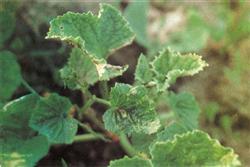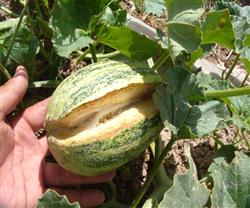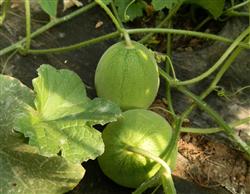Symptoms and control of open-air muskmelon mosaic virus disease

Symptoms: in the early stage of the disease, yellow-green and thick green mosaic spots appeared in the leaves, the leaves became smaller, the leaves were wrinkled, uneven and curled. The main vine is twisted and atrophied, the plant is dwarfed, the melon is small, and the fruit surface is mottled alternately, or slightly bulging. Causes: the incidence of mosaic virus disease is high in recent years, the main causes are: (1) seed carrying virus. (2) there are many weeds in the melon field and its surroundings, and the disease (mainly aphids) spreads severely. (3) it is beneficial to the disease under the bad cultivation and management conditions, such as high temperature and drought, strong sunshine, lack of water, lack of fertilizer, extensive management, poor maturity of organic fertilizer and so on. Prevention and treatment measures: for muskmelon virus disease, the following measures should be taken for prevention and treatment: (1) do a good job of seed treatment. Soak the seeds in 55 ℃ hot water for 40 minutes before sowing to kill the virus in the embryo. (2) thoroughly remove weeds. Clean up the weeds in and around the field as soon as possible to prevent insect parasitism. Melon fields should be kept away from the vegetable garden as far as possible. (3) pay close attention to cultivation and management. Fully apply mature farm manure, increase phosphorus and potassium fertilizer, and supplement zinc and boron micro-fertilizer. Less watering at the seedling stage and ploughing in the middle to enhance the soil permeability. Timely watering and topdressing after flowering can prevent premature senescence and enhance plant disease resistance. When rectifying the vine, the healthy plant and the diseased plant should be operated separately, generally finishing the healthy plant first and then finishing the diseased plant, in order to prevent the spread of sap virus. Using plastic film mulching and proper early sowing can reduce the degree of the disease. (4) Pesticide control. Before the aphid migrates, it can be prevented by spraying 1000 times of imidacloprid. In the seedling stage, the seriously affected plots can be sprayed with virus A 300 times solution plus 0.2% potassium permanganate plus 0.2% zinc sulfate or 300 times solution virus K plus 0.2% potassium permanganate plus 0.01% copper sulfate or 300 times solution plus Fengshou No. 1 1000 times solution plus 0.2% ferrous sulfate. Spray once every 7 days, use in rotation, generally 1-3 times can control the disease. For individual plants, the above solution can be used to irrigate the roots twice, each time 250ml 500ml.
- Prev

Cultivation techniques of muskmelon "three avoidance"
Scientific fertilization. According to the law of fertilizer and water demand during muskmelon growth, balanced supply of fertilizer and water, do not blindly water and fertilize. When fertilizing, we should not only apply sufficient base fertilizer to meet the needs of muskmelon growth in the early stage, but also apply fertilizer in time in the late growth stage of muskmelon to meet the fertilizer requirements of muskmelon growth in the later stage. Reasonable irrigation.
- Next

Management of cultivation techniques of muskmelon in open field
1. Producing conditions: 1.1.The lowest temperature for muskmelon is 15 ℃, the optimum temperature is 18 ℃-32 ℃, and the effective accumulated temperature of ≥ 15 ℃ for the whole growth period is more than 1500 ℃. 1.2 soil conditions, the soil layer is deep, the ph value is 7.0-8.0, the soil salt content is less than 0.3%, and the texture is soil.
Related
- Moge, come on! The staff of the peasant association in the producing area of cantaloupe were frightened when the crowd gathered.
- Causes and Solutions of low Fruit setting rate of Apple
- Symptoms and control measures of passion fruit virus disease
- Fruit growing lesson: how do apple orchards keep high yields?
- Can you build orchards in the mountains? What are the pros and cons?
- How to manage the coloring period of Crisson grape?
- This paper introduces the processing technology of two kinds of fig products.
- How much is a month for retired teachers in rural areas by 2020?
- How can strawberry planting increase sugar content? We should pay attention to management in many aspects.
- What are the cultivation techniques on how to improve the yield of golden fruit?

